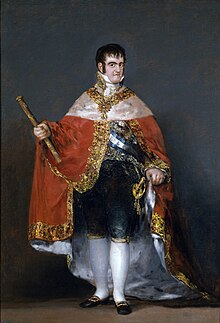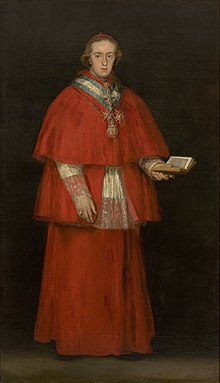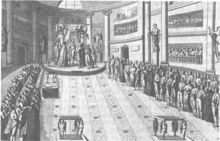Trienio Liberal
In Spain, the liberally ruled years from 1820 to 1823 are called Trienio Liberal (liberal triennium) or Trienio Constitucional (constitutional triennium). It was a constitutional monarchy, in contrast to the absolutist monarchy in the previous and following years. The name arises from the fact that during this period of the reign of Ferdinand VII. Freedoms based on the constitution of Cadiz determined Spanish politics.
prehistory
Constitution of Cadiz
After Ferdinand VII resigned under pressure from Napoleon in May 1808 and lived in the Valençay Castle in France, the Junta Suprema Central met in Aranjuez , whose task it was to take power in the state during the king's absence. This assembly did not recognize the rule of King Joseph and acted in the name, but without commission, of King Ferdinand. This junta convened a constituent assembly on January 1, 1810 . This parliament, known as Cortes generales y extraordinarias , met in Cádiz and created a constitution between September 1810 and March 1812, which was promulgated on March 19, 1812. The Junta Suprema Central and the Consejo de Regencia, which later took its place, and the Cortes of Cádiz created not only the constitution, but also a large number of decrees, laws and edicts that were practically non-existent in the areas to which Joseph's rule was practically non-existent extended, were also applied. The most notable innovations were undoubtedly that the constitution assumed sovereignty of the people, that liberal economic laws were enacted, and that guilds and a large number of tariffs were no longer required. The Catholic faith was still the state religion and the practice of any other religion was forbidden, but the Inquisition was abolished. Monasteries below a certain size should be dissolved and feudal jurisdiction abolished. This newly created legal situation brought the Cortes many opponents in the people as well as in the highest church level. At that time the people were of the conviction that the Inquisition was an indispensable part of the Catholic faith, and the church hierarchy feared for its power.
Sexenio Absolutista
(The absolutist six years between 1814 and 1820) All regulations which the Cortes of Cádiz and the Junta Suprema Central had enacted in his name were declared invalid from the outset by Ferdinand VII on his return from France by the Valencia Manifesto. Ferdinand VII dissolved the Cortes, did not appoint any new Cortes and ruled absolutistically. Many liberal politicians fled abroad before the reaction.
The Spanish economy had hit rock bottom due to the wars. During the time of the king's absence, various colonies had loosened their ties to Spain and declared themselves independent. This led to a loss of almost all of the income from the colonies that had previously flowed into the state budget. During the Sexenio Absolutista, Ferdinand pursued an economic policy that did not really deal with any of the necessary reforms. The finance minister Martín de Garay presented the plan for a tax reform and for the reform of the national debt in 1817. The minister was replaced in 1818. During this time various liberal pronunciamientos were tried, but all failed.
The pronunciamiento of Cabezas de San Juan
On January 1, 1820, a battalion of the expedition corps rose against the absolutist rule of Ferdinand VII in the town of Cabezas de San Juan in the province of Seville . The troops were to set out for the American colonies to put down the uprisings there. The battalion's commander, Lieutenant Colonel Rafael del Riego , called for the Cadiz Constitution to be reinstated. Other militaries joined the call and mutinies. The soldiers marched to Arcos de la Frontera and arrested the captain general of Andalusia and commander-in-chief of the Spanish expedition corps Félix María Calleja del Rey, Count de Calderon. They then took care of themselves in the arsenal in Cadiz and moved to Algeciras , Málaga , Córdoba and Antequera . In these cities the end of absolutism and the return to the basics of the constitution of Cadiz was proclaimed. At the same time there was a revolutionary movement in Galicia that spread to the rest of Spain.
On March 6, Ferdinand issued a decree to convene the Cortes. According to the old law, the convocation should take place as an assembly of estates , i.e. according to the procedure that was used before 1810 to convene the Cortes.
Oath on the Constitution
On March 7, 1820, a large crowd formed in front of the Royal Palace in Madrid. General Francisco Ballesteros , who was responsible for security, refused to use gun violence against the crowd. Thereupon the king felt compelled to announce to his ministers by a new decree that he intended to swear on the constitution of Cadiz and that the new Cortes were to be convened according to the electoral provisions of this constitution.
On March 8, 1820, the king's command was issued to the captains general of the provinces to release all political prisoners immediately. A law proclaiming a general amnesty was passed on April 23rd. This enabled many politicians to return from exile.
On March 9, 1820, the king appointed a junta Provisional Gubernativa in Madrid , which was to exercise the duties and rights of the Cortes in a transitional period.
A decree of March 9, 1820 abolished the Inquisition. The decree refers explicitly to a law passed by the Cortes of Cadiz on February 22, 1813. Those detained for religious reasons should be turned over to the local bishops for treatment according to the prescriptions of the laws of the Cortes.
The most significant turning point in the king's politics is the appeal he addressed to the Spanish nation on March 10th. In which he expressed the insight that new ideas must find their way into political institutions and that harmony between people and the laws could create stability and social peace. He called on the nation to sincerely walk the constitutional path, and be the first to go forward.
Government of the Moderados
On March 18, 1820, Ferdinand VII appointed a new cabinet at the urging of the Junta Provisional Gubernativa . Of the seven ministers, only two, the Naval Minister and the War Minister, had not been members of the Cortes of Cadiz . The lack of cooperation between the King and the Cabinet was one of the great difficulties that paralyzed government and administration in the country.
In the decree of March 22, 1820, the king then convened the Cortes for the years 1820 and 1821. At the opening session of the Cortes on July 9, 1820, there was a clear majority of members of the moderate wing of the Liberals ( Moderados ). There were two currents among liberal politicians. At that time it was not really possible to speak of parties as there was no organizational connection. The Doceañistas (from doce twelve, 1812, the year the Constitution of Cádiz was passed) were mostly participants in the Cortes of Cádiz. The politicians of this political wing saw their goals as essentially achieved by the enactment of the constitution. Important representatives of this group, also known as Moderados , were Agustín Argüelles and Francisco Martínez de la Rosa . In principle, they were ready to compromise and to work with the Crown in order to set a further reform process in motion. For the politicians of the other wing, the Veinteañistas (von veinte twenty, 1820), the goal of political changes through the enactment of the constitution had not yet been achieved. The moderados described their demands for further changes as exaggerated. This is where the name Exaltados comes from. The group, which continued to advocate progress in society reform, later came to be known as Progresistas .
The Cortes, elected in 1820, set about continuing the reforms of the Cortes of Cádiz, but were by no means able to build on them directly. The laws that were drawn up in the period from 1810 to 1814 had to be adapted to the changed conditions. This concerned laws on the abolition of property ties such as B. Majorate , the prohibition of the purchase of land by the church, the expulsion of the Jesuits and the reform of the Christian orders. The constitution gave the king a veto right . He could refuse to sign a law twice and refer it back to the Cortes. Only on the third bill was the king forced to proclaim the law. The king made full use of this right. B. in a law that the disamortization of a large number of monasteries provided. This led to further clashes with the cabinet. After the opening of the second session of the Cortes on March 1, 1821, the king dismissed the ministers. The new cabinet, however, clearly consisted of liberal politicians from the moderate wing. The budget presented by this Cabinet showed a deficit of 550 million reales , which was to be covered by borrowing abroad and by a national loan. The Cortes carried out two important administrative reforms, both of which served to strengthen centralized administration. On the one hand, the country was divided into 49 provinces with corresponding tax authorities to enable easier and safer tax collection. On the other hand, the Public Education Act divided the education system into basic, middle and higher education. The number of universities was fixed at ten and the autonomy of universities was restricted by the introduction of a national curriculum.
Government of the Exaltados
From October 1821 there were repeated uprisings and unrest all over the country. The reason for this was on the one hand the economic situation, which had not improved in the last two years, on the other hand also the dissatisfaction of some political groups for whom the social changes did not go fast enough and did not go far enough. The elections in 1822 resulted in a majority of the Exaltados in the Cortes. Rafael del Riego , who had received a parliamentary seat in an Asturian constituency, was elected chairman of the Cortes. The work of parliament almost came to a standstill as a result of the fighting among the liberals. In August the King appointed Evaristo de San Miguel, a politician from the Exaltados, to be Prime Minister.
At the end of 1822, too, riots broke out again. These were initiated on the one hand by groups that were close to the Exaltados and demanded stricter implementation of progressive politics. On the other hand, the unrest emanated from absolute monarchists who began to organize themselves more and more. The greatest domestic political challenge for the government in Madrid was the Regencia de Urgel , a counter-government that found a large number of supporters, especially in Catalonia, Aragon and in the north of the island. The unrest could be stopped for the time being through the deployment of troops under General Francisco Espoz y Mina. The members of the Regencia de Urgel fled to France.
French invasion
A far greater danger than internal unrest came from the Holy Alliance , which at its Verona Congress on November 22, 1822, with the consent of the representatives of Austria, France, Prussia and Russia, but without the voice of England, reassigned the French government in Spain to restore the state of affairs as it existed before the revolution of Cadiz. The French government assembled an army under the command of the Duke of Angoulême , nephew of King Louis XVIII. was standing. The army came to be known as Los cien mil hijos de San Luis (The Hundred Thousand Sons of Saint Louis). A large number of the Spanish supporters of the absolute monarchy who fled to France also fought in this army. On April 2, 1823, the Duke of Angoulême called on the Spaniards not to oppose any resistance to the French army and united with them to free the king and restore the altar and throne. Three of the four army corps, around 79,000 soldiers, crossed the Spanish border in the west near San Sebastián. A fourth army corps, consisting of around 21,000 soldiers, approached Barcelona in the east via Figueras. The bulk of the invading army was able to take Madrid without encountering significant resistance. The Duke of Angoulême set up a Regency Council in Madrid. under the Duke del Infantado. This Regency Council exercised the rights of King Ferdinand VII in Madrid until October 1, 1823.
End of the Trienio Liberal
In view of the threatening situation, the Cortes decided on March 22, 1823 to move their seat and that of the government and the king from Madrid to Seville. In the first meeting in Seville on June 11, 1823, the Cortes issued a decree in which they set up a Regency Council according to Art. 187 of the Constitution of Cádiz, since in their opinion the king was mentally incapable of performing his duties. The chairman of the three-member council was Cayetano Valdés , former captain general of Cádiz , assisted by Gaspar de Vigodet and Gabriel Ciscar y Ciscar . In mid-June, the Cortes moved their seat and that of the government and the king to Cádiz. The last meeting of the Cortes took place on September 19, 1823.
After the military pressure of the French army became unbearable for the Spaniards in Cadiz, Valdés handed the king over to the Duke of Angoulême in the last days of September .
In the manifesto of October 1, 1823, which was still signed in Santa Maria , King Ferdinand VII declared that he had not been free in his actions since March 7, 1820 and therefore all actions of the governments from this date to May 1. October 1823 are to be regarded as invalid from the outset. After his return to Madrid, the king ruled absolutist again. The ten years that follow the “liberal triennium” are referred to in Spain as the “Disastrous Decade” ( Década Ominosa ), which is dated to the death of Ferdinand VII.
General Rafael del Riego , captured by French troops in Arquillos in the province of Jaén on September 15, 1823 , was handed over to the new Spanish government and executed in Madrid on November 7, 1823.
The French troops stayed in Spain until 1828.
Individual evidence
- ^ Convocatorias de la Junta Central
- ↑ Text of the Constitution of Cadiz on Wikisource (Spanish)
- ↑ Manifesto del Rey (DOC file; 64 kB) from May 4, 1814, on cchs.csic.es, viewed August 4, 2010 (Spanish, Word document)
- ↑ Decree of March 6, 1820 in which the Cortes are convened according to the old laws. In Documentos Tomo IS 87.
- ^ Decree of March 7, 1820 in which the king announced that he would take an oath on the constitution. In Documentos Tomo IS 88
- ↑ Decree of March 8, 1820, which orders the release of all who are in captivity because of their political opinion. In Documentos Tomo IS 92.
- ↑ Decree of March 9, 1820 in which the king declares that he has selected a junta Provisional. In Documentos Tomo IS 93
- ^ Decree of March 9, 1820, which dissolves the Inquisition. In Documentos Tomo IS 93
- ^ Call of the king of March 10, 1820 to the Spanish nation in Documentos Tomo IS 91
- ↑ Diccionario biográfico de los ministros españoles en la edad contemporánea 1808 - 2000 on cchs.csic.es, viewed August 5, 2010 (Spanish)
- ↑ Decree of March 22, 1820 in which the normal Cortes are convened for the years 1820 and 1821 In Documentos Tomo IS 94
- ↑ Appeal from His Royal Highness the Duke of Angoulême to the Spaniards Documentos Tomo II. P. 240
- ^ Map "Path of the 100,000 Sons of Saint Ludwig"
- ↑ Decree of His Royal Highness the Duke of Angoulême of May 25, 1823 which establishes a reign during the captivity of His Majesty Ferdinand VII Documentos In Tomo II. P. 248
- ↑ Decree of the Cortes, given in Seville on June 11, 1823 in which a regency is appointed. In Documentos Tomo II. P. 293
swell
- Marqués de Miraflores: Documentos… sobre la Revolución de España, Oficina de Ricardo Taylor, London 1834 Volumes I. + II. Digitized Tomo I , digitized Tomo II
- Sources about the reign of Ferdinand VII.
literature
- Walther L. Bernecker : Spanish history, from the 15th century to the present. CH Beck, Munich 1999, ISBN 3-406-43311-1
- Hans-Otto Kleinmann : Between Ancien Regime and Liberalism (1808-1874). In: Peer Schmidt (ed.): Small history of Spain. Federal Agency for Civic Education, Bonn 2005, ISBN 3-89331-652-3 , pp. 253–328.
Web links
- http://www.iescasasviejas.net/histo/tema6.htm
- Biography Rafael del Riego y Núñez ( Memento from February 25, 2008 in the Internet Archive ) on fuenterrebollo.com, in the Internet Archive on archive.org, as of February 25, 2008, viewed August 5, 2010 (Spanish)





